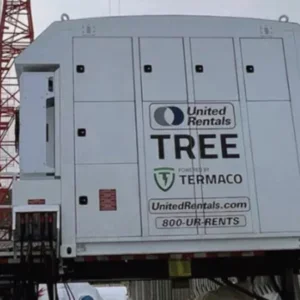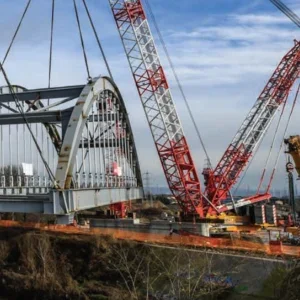Sheffield Insulations supplies building insulation materials to construction sites in the UK. It had been aware that some of its traditional methods of delivering materials to sites were not the most efficient. Typically, vehicle unloading was being done by small loader cranes or by truck-mounted forklifts, both of which meant leaving vulnerable materials standing either at the roadside or at the base of hoists. In some cases, tower cranes were used to offload directly from the truck platform to the roof of the building. But in all these instances, further manual handling inevitably exposed products to the risk of damage from impact or weather.
“In the London area, about 50% of the product that we deliver is interior boarding or drylining material which is not only at risk of damage if not handled correctly but, if it gets wet, is useless and has to be dumped”, explains divisional manager Colin Richardson. “If we could find a way of eliminating rehandling, it would give major benefits for all concerned. But, for it to be a truck loader solution, it would have to be something far bigger and much more universal than we had seen before.” Sheffield Insulations studied the operations of its sister company in Germany, where large, multi-section truck loaders are used, and decided to take the concept back to the UK. As Richardson explains: “It is really quite simple – the ability to deliver materials directly to their point of use on many high rise contracts is faster, more cost-efficient and reduces problems of damage caused by needless rehandling,” Following market evaluation and some complex engineering studies, Sheffield placed an order for a Fassi F420 AXP with fly jib to be fitted to a Mercedes 2640S 6 x 4 tractor unit and Corus flat-bed trailer. The crane can lift palletised materials directly from the truck bed and deliver them to their point of use up to the eighth floor level on construction sites.
In preparing a specification for the new crane, Fassi and its London area dealer, Walker Crane Services, used computer calculations from which its optimum overall performance could be determined. To stay within guidelines, this involved a fine balancing act between tractor axle loadings, trailer payload and loader performance.
The initial idea of using a four-axle rigid truck was changed to a tractor unit and semi-trailer, increasing the maximum payload by 30%, to almost 20t. To provide the required lifting performance, the Fassi loader was specified with a six-section boom, giving a lifting height of more than 26m, at which height it can handle the combined 1.5t weight of a typical pallet-load of insulation materials plus the weight of the pallet handler.
Designed to fold and embrace each complete pallet load, the Kinshofer KN16 fork handler protects the material and creates a compact unit that is small enough to pass through most apertures in part-completed buildings. Its manipulation controls can be used in combination with the extending fly-jib, enabling pallets to be horizontally fed through openings or placed precisely on gantry platforms.
All hydraulic functions of the crane and the pallet handler, together with master control of the engine unit, can be operated by conventional controls on the tractor or by a Scanreco radio remote control.
Carl Waters, transport manager of Sheffield Insulations, believes that the new unit will operate as a fully autonomous rig, under the control of a single driver/operator. “One of the key reasons for autonomous operation is the versatility of radio remote control of the loader. It means that the operator can walk up to the drop point on the relevant floor level of the building, taking the control console with him,” he says.
Although the new loader has been in service only a couple of months, its has been tried out on several major construction sites in the London area. Customer reaction has been favourable and the long loader delivery and handling technique is already being regarded as the way forward for delivery to sites in urban areas, the company says.
Summarising the benefits, Colin Richardson believes that the average time spent by vehicles on site will be cut by about half. “Because we are delivering material directly up to the required floor level, rather than dropping pallets on to the ground or using tower cranes to lift it to the roof, we eliminate the manpower needed to move it to the point of use. We also deliver product on its pallet and still in its original packing, which need not be broken open until it is ready for use.”






